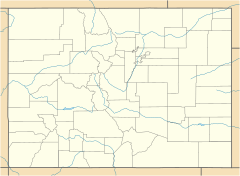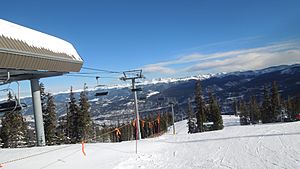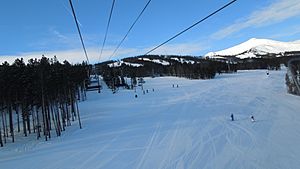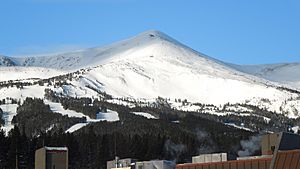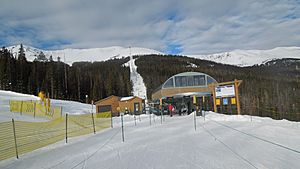Breckenridge Ski Resort facts for kids
Quick facts for kids Breckenridge |
|
|---|---|
 |
|
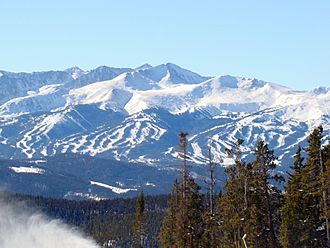
Peaks 8, 9 and 10 viewed from
Dercum Mountain at Keystone Resort |
|
| Location | White River National Forest Summit County, Colorado |
| Nearest city | Breckenridge |
| Coordinates | 39°28′48″N 106°04′01″W / 39.480°N 106.067°W |
| Vertical | 3,398 feet (1,036 m) |
| Top elevation | 12,998 feet (3,962 m) |
| Base elevation | 9,600 feet (2,900 m) |
| Skiable area | 2,908 acres (11.77 km2) |
| Runs | 155 total |
| Longest run | Four O'Clock 3.5 miles (5.6 km) |
| Lift system | 32 total (1 gondola, 5 high-speed six-packs, 5 high-speed quads, 1 fixed grip quad, 1 triple chairlift, 6 double chairlifts, 13 surface) |
| Terrain parks | 25 acres (10 ha) |
| Snowfall | 370 in (940 cm) per year |
| Snowmaking | 600 acres (2.4 km2) |
| Night skiing | none |
| Website | breckenridge.com |
Breckenridge Ski Resort is a popular ski area in the western United States. It is located in Breckenridge, Colorado, near the Continental Divide. Many people visit Breckenridge each year, making it one of the most popular ski resorts in the western hemisphere. Vail Resorts, Inc. owns and operates the resort.
Contents
History of Breckenridge Ski Resort
Early Days (1960s-1970s)
Breckenridge Ski Resort first opened on December 16, 1961. It started with trails on Peak 8. The main lift was a double chairlift. In 1965, another lift was added to serve the south side of Peak 8. The resort also added a special platter lift in 1967 for higher areas.
In 1970, the Aspen Skiing Company bought Breckenridge. The resort grew onto Peak 9, adding more chairlifts. In 1979, a fun alpine slide was built on Peak 8. It has three fiberglass tracks for different speeds. The slide is still a popular summer activity today.
Growth and New Lifts (1980s-1990s)
After a dry winter in 1980-1981, Breckenridge installed snowmaking systems. This helped make sure there was always enough snow. In 1981, the resort added a very modern lift called the Quicksilver Quad. It was one of the first high-speed detachable quad chairlifts in the world.
In 1985, Breckenridge expanded to Peak 10. A new high-speed quad lift, the Falcon SuperChair, was built there. The runs on Peak 10 were named after World War II planes. In 1986, the Colorado SuperChair was built on Peak 8. This made it easier to get around the mountain.
By 1988, over a million skiers visited Breckenridge in one season. The resort was sold to a company from Tokyo. In 1993, Ralston-Purina bought Breckenridge. They also owned Keystone Resort and Arapahoe Basin.
In 1996, Vail Resorts purchased Breckenridge and Keystone. They also owned Beaver Creek and Vail Ski Resort. The Snowflake double chairlift was also built in 1996. It helps people from nearby homes get to the mountain. In 1997, two old lifts were replaced with new high-speed quads. These were the Mercury SuperChair on Peak 9 and the Rocky Mountain SuperChair on Peak 8.
In 1999, the Quicksilver SuperChair was upgraded to a high-speed six-pack. This lift is special because it has two loading areas. This helps more people get on the lift faster.
Modern Expansions (2000s-2010s)
In 2002, Breckenridge had a big expansion. They opened new trails on Peak 7. The Independence SuperChair, a high-speed six-pack, was built there. A new high-speed quad, the Peak 8 SuperConnect, also opened. It made it much easier to travel between Peak 9 and Peak 8.
In 2005, the Imperial Express SuperChair was built on Peak 8. This lift is the highest operating chairlift in North America! It takes skiers to the top of Peak 8, cutting a long hike into a quick 3-minute ride.
A new eight-person gondola, the BreckConnect Gondola, opened in 2007. It connects the town of Breckenridge to the Peak 8 base area. It also stops at Shock Hill and Peak 7. This gondola makes it very easy to get to the slopes from town.
From 2008 to 2010, One Ski Hill Place was built at the Peak 8 base. It has a food court and a lounge. A new base area also opened on Peak 7 with two large lodges.
In 2010, the GoldRunner Coaster was built near Lift 7. This alpine coaster is fun in both winter and summer. The 2011–12 season was Breckenridge's 50th anniversary!
In 2013, Breckenridge opened a huge new area on Peak 6. This added 543 acres of terrain. It was the first big expansion at a Colorado ski resort since 2002. Two new lifts were built: the Zendo Chair (a fixed-grip quad) and the Kensho SuperChair (a high-speed six-pack). The Kensho SuperChair is the second highest lift on the mountain. The names of the trails on Peak 6 were chosen by people on Facebook!
In 2014, the Colorado SuperChair was upgraded to a high-speed six-pack. It can now carry 3,600 people per hour. This helps reduce waiting times on Peak 8. It also has a special conveyor belt to help people load easily.
In 2017, the Falcon SuperChair on Peak 10 was upgraded to a high-speed six-pack. Now, each of the five peaks has its own high-speed six-pack lift.
Mountain Layout
Breckenridge Ski Resort is spread across five different peaks. These peaks are part of the Tenmile Range. They are numbered from south to north, starting with Peak 10 and ending with Peak 6.
Peak 10
Peak 10 is the southernmost peak. It has trails for advanced and expert skiers. You can reach it using the Falcon SuperChair. The terrain here includes groomed black diamond runs, tree skiing (glades), and steep chutes.
Peak 9
Peak 9 is the second oldest peak. The lower part of Peak 9 is perfect for beginners. It is accessed by the Quicksilver Super6 and Lift A. The upper part has blue (intermediate) runs. These are served by the Mercury SuperChair, Beaver Run SuperChair, and Lift C. On the north side, there are challenging double black chutes called the North Chutes.
Peak 8
Peak 8 is the center of the resort. It has a wide variety of terrain. The lower part of Peak 8 has beginner, intermediate, and some advanced trails. Lifts like Rip's Ride, 5 Chair, Colorado SuperChair, and Rocky Mountain SuperChair serve this area. Peak 8 is also home to famous terrain parks like Freeway and Park Lane. These parks are used by professional skiers and snowboarders.
The upper part of Peak 8 has advanced and expert terrain. This includes steep chutes. The Imperial Express SuperChair is the highest chairlift in the world. It takes you to the Imperial Bowl and the Lake Chutes. The Lake Chutes are very steep, dropping about 400 feet (120 m) at a 55-degree angle. You can also hike from the Imperial lift to the very top of Peak 8 for even more challenging runs.
Peak 7
Peak 7 has rolling intermediate trails that are groomed every night. You can reach its bowls by hiking or traversing from Peak 8. The Peak 7 base area has two large lodges and a restaurant. It is connected to town by the BreckConnect Gondola. The Independence SuperChair serves the terrain on Peak 7. The Zendo lift, which goes to Peak 6, also starts here.
Peak 6
Peak 6 is mainly for intermediate skiers and riders who want to experience bowl terrain. It also has many advanced trails and chutes. You can get to Peak 6 from Peak 7 using the Zendo Chair. From the Horizon warming hut, the Kensho SuperChair takes you above the tree-line to 12,302 feet (3,750 m). This is the world's highest elevation six-pack lift! It gives you direct access to intermediate bowl trails and expert chutes.
Slope Directions
- North-facing slopes: 20%
- South-facing slopes: 20%
- East-facing slopes: 60%
- West-facing slopes: 0%
Lifts
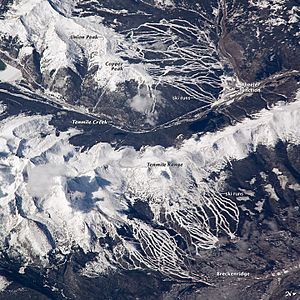
Breckenridge has 34 lifts in total:
- 5 high-speed six-packs: Falcon SuperChair (Peak 10), Quicksilver SuperChair (Peak 9), Colorado SuperChair (Peak 8), Independence SuperChair (Peak 7), Kensho SuperChair (Peak 6)
- 5 high-speed quads: Mercury SuperChair (Peak 9), Beaver Run SuperChair (Peak 9), Peak 8 SuperConnect (Peaks 9 and 8), Rocky Mountain SuperChair (Peak 8), Imperial Express SuperChair (Peak 8)
- 1 fixed-grip quad: Zendo (Peak 6)
- 1 triple lift: Lift A (Peak 9)
- 6 double lifts: Lift C (Peak 9), Lift E (Peak 9), Snowflake (Town and Peak 8), Rip's Ride/Lift 7 (Peak 8), Lift 5 (Peak 8), Lift 6 (Peak 8)
- 4 surface lifts: T-Bar (Peak 8, for public), Trygve's Platter (Peak 8, for ski school), Eldorado Platter (Peak 9, for ski school), Camelback Platter (Peak 9, for ski school)
- 9 carpet lifts (all for ski school)
- 1 eight-person gondola: Breckconnect Gondola (Town, Shock Hill, Peak 7, Peak 8)
Dew Tour
From 2008 to 2019, Breckenridge hosted the Winter Dew Tour every December. This is a big event where top athletes compete in skiing and snowboarding. In 2020, the event moved to Copper Mountain.
Images for kids


